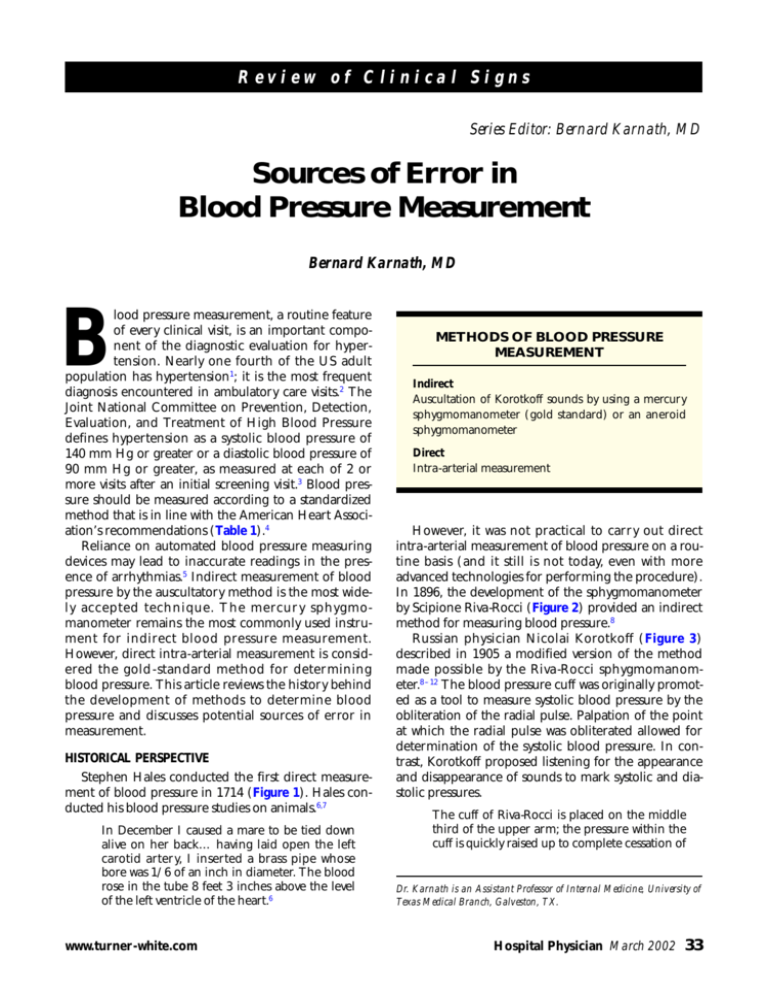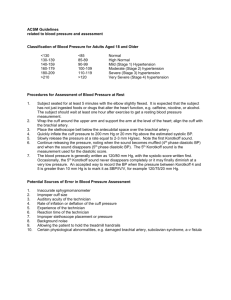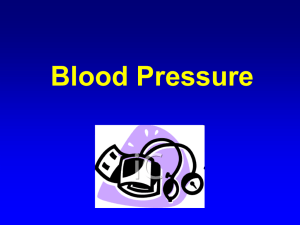
Review of Clinical Signs
Series Editor: Bernard Karnath, MD
Sources of Error in
Blood Pressure Measurement
Bernard Karnath, MD
lood pressure measurement, a routine feature
of every clinical visit, is an important component of the diagnostic evaluation for hypertension. Nearly one fourth of the US adult
population has hypertension1; it is the most frequent
diagnosis encountered in ambulatory care visits.2 The
Joint National Committee on Prevention, Detection,
Evaluation, and Treatment of High Blood Pressure
defines hypertension as a systolic blood pressure of
140 mm Hg or greater or a diastolic blood pressure of
90 mm Hg or greater, as measured at each of 2 or
more visits after an initial screening visit.3 Blood pressure should be measured according to a standardized
method that is in line with the American Heart Association’s recommendations (Table 1).4
Reliance on automated blood pressure measuring
devices may lead to inaccurate readings in the presence of arrhythmias.5 Indirect measurement of blood
pressure by the auscultatory method is the most widely accepted technique. The mercur y sphygmomanometer remains the most commonly used instrument for indirect blood pressure measurement.
However, direct intra-arterial measurement is considered the gold - standard method for determining
blood pressure. This article reviews the history behind
the development of methods to determine blood
pressure and discusses potential sources of error in
measurement.
B
HISTORICAL PERSPECTIVE
Stephen Hales conducted the first direct measurement of blood pressure in 1714 (Figure 1). Hales conducted his blood pressure studies on animals.6,7
In December I caused a mare to be tied down
alive on her back… having laid open the left
carotid artery, I inserted a brass pipe whose
bore was 1/6 of an inch in diameter. The blood
rose in the tube 8 feet 3 inches above the level
of the left ventricle of the heart.6
www.turner-white.com
METHODS OF BLOOD PRESSURE
MEASUREMENT
Indirect
Auscultation of Korotkoff sounds by using a mercury
sphygmomanometer (gold standard) or an aneroid
sphygmomanometer
Direct
Intra-arterial measurement
However, it was not practical to carry out direct
intra-arterial measurement of blood pressure on a routine basis (and it still is not today, even with more
advanced technologies for performing the procedure).
In 1896, the development of the sphygmomanometer
by Scipione Riva-Rocci (Figure 2) provided an indirect
method for measuring blood pressure.8
Russian physician Nicolai Korotkoff (Figure 3)
described in 1905 a modified version of the method
made possible by the Riva-Rocci sphygmomanometer.8 – 12 The blood pressure cuff was originally promoted as a tool to measure systolic blood pressure by the
obliteration of the radial pulse. Palpation of the point
at which the radial pulse was obliterated allowed for
determination of the systolic blood pressure. In contrast, Korotkoff proposed listening for the appearance
and disappearance of sounds to mark systolic and diastolic pressures.
The cuff of Riva-Rocci is placed on the middle
third of the upper arm; the pressure within the
cuff is quickly raised up to complete cessation of
Dr. Karnath is an Assistant Professor of Internal Medicine, University of
Texas Medical Branch, Galveston, TX.
Hospital Physician March 2002
33
Karnath : Blood Pressure Measurement : pp. 33 – 37
Table 1. Recommendations for Blood Pressure
Measurement
1. Seat the patient with his or her arm supported in such a
manner that the midpoint of the upper arm is at the
level of the heart.
2. Select an appropriately sized cuff. The cuff bladder
should encircle 80% of the arm in adults and 100% of
the arm in children younger than 13 years.
3. Wrap the cuff around the bare upper arm, centering the
bladder over the brachial artery. The lower edge of the
cuff should be 2 cm above the antecubital fossa.
4. The cuff should be inflated while palpating the radial
pulse to approximate systolic blood pressure, which is
the point at which the radial pulse disappears.
5. The bell of the stethoscope should be placed just above
and medial to the antecubital fossa.
6. The cuff should be inflated to a pressure 20 to 30 mm
Hg above the point at which the radial pulse disappears.
7. The cuff should be deflated at a rate of 2 mm Hg per
second.
8. The systolic blood pressure is recorded at the appearance of Korotkoff sounds (phase I).*
9. The diastolic blood pressure is recorded at the disappearance of Korotkoff sounds (phase V) in adults and
the muffling of sounds (phase IV) in children.*
10. Repeat the procedure in the opposite arm.
NOTE: points 1 through 9 adapted from Perloff et al.4
*See Table 2 in this article.
circulation below the cuff…. It follows that the
manometric figure at which the first tone
appears corresponds to the maximal blood
pressure…. The time of the cessation of sounds
indicates the free passage of the pulse wave…. It
follows that the manometric figure at this time
corresponds to the minimal blood pressure.11
Goodman and Howell in 1911 recommended the
division of the changing sounds into 5 distinct phases,
and physicians subsequently determined diastolic
blood pressure according to either the point of
muffling of sounds or the disappearance of sounds
(Table 2).12
DIRECT VERSUS INDIRECT MEASUREMENTS OF BLOOD
PRESSURE
As previously stated, direct intra-arterial measurement is considered the gold-standard method for the
measurement of blood pressure. A study by Chyun compared intra-arterial (direct) and auscultatory (indirect)
34 Hospital Physician March 2002
Figure 1. Stephen Hales in 1714. Reprinted from Hall WD.
Stephen Hales: Theologian, botanist, physiologist, discoverer
of hemodynamics. Clin Cardiol 1987;10:488 with permission
from Clinical Cardiology Publishing Company, Inc, and/or the
Foundation for Advances in Medicine and Science, Inc.
readings in 14 intensive care unit patients and found
that the auscultatory method overestimated the systolic
and diastolic blood pressures.13 Furthermore, use of the
phase IV Korotkoff sounds (Table 2) as an indicator of
diastolic blood pressure can overestimate readings by as
much as 20 mm Hg as well.13 Direct intra-arterial measurement of blood pressure is often used to monitor critically ill patients.
SOURCES OF ERROR IN MEASUREMENT
Several critical steps in measuring blood pressure
are selection of an appropriately sized cuff, cuff placement, proper placement of the bell of the stethoscope,
appropriate cuff deflation rate, and auscultation of
appropriate Korotkoff sounds. Sources of error in
blood pressure measurement include improper technique, observer bias, and faulty equipment. In addition, the presence of clinical conditions such as atrial
fibrillation can lead to a high degree of interobserver
variability.
www.turner-white.com
Karnath : Blood Pressure Measurement : pp. 33 – 37
Figure 2. The Riva-Rocci sphygmomanometer. Reprinted with
permission from Brown WC, O’Brien ET, Semple PF. The
sphygmomanometer of Riva -Rocci 1896 – 1996. J Hum
Hypertens 1996;10:723–4.
Technique
McKay and colleagues evaluated physicians for common errors in blood pressure measurement technique,
which included use of an inappropriately sized cuff,
failure to allow a rest period before measurement, not
measuring blood pressure in both arms, and failure to
palpate maximal systolic blood pressure before auscultation.14,15 Furthermore, fewer than 20% of physicians
followed a proper cuff deflation rate of 2 mm Hg per
second.14,15 Rapid cuff deflation leads to underestimates of systolic pressure and overestimates of diastolic
blood pressure.16 Also, cuff size can affect blood pressure readings. A blood pressure cuff that is too small
can lead to overestimates of systolic and diastolic pressures; a cuff that is too large can lead to underestimates
of these pressures.16
Blood pressure should be measured with the patient
in a sitting position. The patient should be seated with
his or her arm supported in such a manner that the midpoint of the upper arm is at the level of the heart. Failure
to follow these procedures can lead to falsely elevated
blood pressure measurements if the midpoint of the
upper arm is lower than the heart level and even higher
measurements if the midpoint is above the heart level.16
www.turner-white.com
Figure 3. Nicolai Korotkoff. Reprinted with permission from
Segall HN. N. C. Korotkoff—1874 –1920—Pioneer vascular
surgeon. Am Heart J 1976;91:816–8.
Korotkoff sounds are low frequency sounds and are
therefore heard more clearly with the bell of the
stethoscope. A study by Prineas and Jacobs evaluated
the differences between blood pressure readings obtained with the bell of the stethoscope and those
obtained with the diaphragm.17 The results of the study
showed that when the bell of the stethoscope was
placed over the brachial artery, a higher systolic and
lower diastolic reading was obtained than when the
diaphragm was placed over the antecubital fossa.17 The
results of the study also suggested that Korotkoff
sounds are detected earlier and disappear later when
the bell of the stethoscope is placed over the brachial
artery, as suggested by the American Heart Association.
Observer Bias
A study by Neufeld and Johnson evaluating 26 physicians with regard to their abilities to measure blood pressure found standard deviations of 3.5 and 5.7 mm Hg for
systolic and diastolic blood pressures, respectively.18 The
higher degree of standard deviation for diastolic blood
pressure was attributed to observer bias in using phase IV
Korotkoff sounds as the indicator for diastolic blood pressure. Phase V Korotkoff sounds are the preferred measuring point for diastolic blood pressure measurement in
adults. As previously mentioned, use of phase IV
Korotkoff sounds has been shown to overestimate
Hospital Physician March 2002
35
Karnath : Blood Pressure Measurement : pp. 33 – 37
Table 2. Phases of Korotkoff Sounds
Phase
Characteristics
I
First appearance of low-frequency tapping sounds
II
Softer and longer sounds
III
Crisper and louder sounds
IV
Muffled and softer sounds
V
Complete disappearance of sounds
diastolic blood pressure by as much as 20 mm Hg when
compared with intra-arterial readings.18 Furthermore,
phase IV Korotkoff sounds are not reproducible among
clinicians, whereas phase V sounds are.19 Some physicians
record both phase IV and phase V Korotkoff sounds.
Thus, a blood pressure measurement may read as
140/80/50, with the last 2 numbers being 2 different
diastolic blood pressure readings.
Faulty Equipment
Mercury sphygmomanometers should be considered inaccurate if the meniscus is not at 0 at rest. Aneroid (rotating needle–type) sphygmomanometers are
more popular than mercury sphygmomanometers
because of the potential environmental toxicity of mercury. However, aneroid sphygmomanometers require
regular calibration and may become very inaccurate
over time. Aneroid sphygmomanometers should be
validated for accuracy against a standard mercury manometer at 6-month intervals.20
Atrial Fibrillation
Atrial fibrillation is the most common arrhythmia in
elderly persons. Atrial fibrillation is commonly associated with hypertension, and the irregularly irregular
pulse makes blood pressure measurement more difficult. It is estimated that approximately 2.3 million US
adults currently have atrial fibrillation.21 The use of
automated devices in the presence of atrial fibrillation
may lead to inaccurate readings.5
Moreover, interobserver variability among physicians can be significant with regard to patients with
atrial fibrillation. A study by Sykes and colleagues prospectively evaluated interobserver variability in blood
pressure measurement for patients with atrial fibrillation and patients with sinus rhythm and found a significantly greater degree of variability for patients with atrial fibrillation for both systolic and diastolic pressures.22
The findings of the study suggested that physicians’
interpretations of Korotkoff sounds are less uniform in
the presence of atrial fibrillation.22
36 Hospital Physician March 2002
The Auscultatory Gap
Failure to detect an auscultatory gap is another
potential source of error in blood pressure measurement and will likely result in falsely lower systolic readings.23 The auscultatory gap is a period of abnormal
silence that usually occurs during the phase 2
Korotkoff period, from 10 to 50 mm Hg. The pathogenesis of the auscultatory gap is not clearly understood but an association with atherosclerosis has been
documented.24 Palpation of the radial pulse during
cuff inflation will ensure that an auscultatory gap is not
missed.23
White-Coat Hypertension
White-coat hypertension is a condition in which a
normotensive patient displays hypertensive blood pressure readings during a clinical encounter. White-coat
hypertension is present in approximately 25% of people who appear to have hypertension through conventional measurement.25 Anxiety can raise blood pressure
by as much as 30 mm Hg. This response is most severe
at the beginning of a clinical encounter; ambulatory
blood pressure monitoring is useful in differentiating
white-coat hypertension from persistent hypertension.16
CONCLUSION
A standardized method, such as the protocol recommended by the American Heart Association, should be
used when determining blood pressure to ensure accurate measurements. Reliance on automated devices may
lead to inaccurate readings in the presence of arrhythmias. Mercury sphygmomanometers are considered the
gold-standard measuring devices for indirect blood
pressure determination; aneroid sphygmomanometers
are considered accurate if calibrated with a mercury
manometer at regular intervals. The measurement of
blood pressure through auscultation remains the most
widely accepted method in everyday practice.
HP
REFERENCES
1. Wolz M, Cutler J, Roccell EJ, et al. Statement from the
National High Blood Pressure Education Program: prevalence of hypertension. Am J Hypertens 2000;13:103–4.
2. Vital and health statistics. National Ambulatory Medical
Care Survey: 1993 Summary. Available at http://www.cdc.
gov/nchs/data/series/sr_13/sr13_136.pdf. Accessed 18
Jan 2002.
3. The sixth report of the Joint National Committee on
Prevention, Detection, Evaluation, and Treatment of
High Blood Pressure. [published erratum appears in
Arch Intern Med 1998;158:573]. Arch Intern Med 1997;
157:2413–46.
4. Perloff D, Grim C, Flack J, et al. Human blood pressure
www.turner-white.com
Karnath : Blood Pressure Measurement : pp. 33 – 37
5.
6.
7.
8.
9.
10.
11.
12.
13.
14.
determination by sphygmomanometry. Circulation
1993;88:2460–70.
Shuler CL, Allison N, Holcomb S, et al. Accuracy of an
automated blood pressure device in stable inpatients:
optimum vs routine use. Arch Intern Med 1998;158:
714–21.
Hall WD. Stephen Hales: theologian, botanist, physiologist, discoverer of hemodynamics. Clin Cardiol 1987;
10:487–9.
Lewis O. Stephen Hales and the measurement of blood
pressure. J Hum Hypertens 1994;8:865–71.
Brown WC, O’Brien ET, Semple PF. The sphygmomanometer of Riva-Rocci 1896–1996. J Hum Hypertens
1996;10:723–4.
Segall HN. How Korotkoff, the surgeon, discovered the
auscultatory method of measuring arterial pressure.
Ann Intern Med 1975;83:561–2.
Segall HN. N.C. Korotkoff—1874–1920—Pioneer vascular surgeon. Am Heart J 1976;91:816–8.
Cantwell JD. Profiles in cardiology. Nicolai S. Korotkoff
(1874–1920). Clin Cardiol 1989;12:233–5.
Crenner CW. Introduction of the blood pressure cuff
into U.S. medical practice: technology and skilled practice. Ann Intern Med 1998;128:488–93.
Chyun DA. A comparison of intra-arterial and auscultatory blood pressure readings. Heart Lung 1985;14:223–31.
McKay DW, Raju MK, Campbell NR. Assessment of
blood pressure measuring techniques. Med Educ 1992;
26:208–12.
15. McKay DW, Campbell NR, Parab LS, et al. Clinical assessment of blood pressure. J Hum Hypertens 1990;4:639–45.
16. Baker RH, Ende J. Confounders of auscultatory blood
pressure measurement. J Gen Intern Med 1995;10:
223–31.
17. Prineas RJ, Jacobs D. Quality of Korotkoff sounds: bell vs
diaphragm, cubital fossa vs brachial artery. Prev Med
1983;12:715–9.
18. Neufeld PD, Johnson DL. Observer error in blood pressure measurement. CMAJ 1986;135:633–7.
19. Shennan A, Gupta M, Halligan A, et al. Lack of reproducibility in pregnancy of Korotkoff phase IV as measured by mercury sphygmomanometry. Lancet 1996;
347:139–42.
20. Canzanello VJ, Jensen PL, Schwarts GL. Are aneroid
sphygmomanometers accurate in hospital and clinic settings? Arch Intern Med 2001;161:729–31.
21. Go AS, Hylek EM, Phillips KA, et al. Prevalence of diagnosed atrial fibrillation in adults. JAMA 2001;285:2370–5.
22. Sykes D, Dewar R, Mohanaruban K, et al. Measuring
blood pressure in the elderly: does atrial fibrillation
increase observer variability? BMJ 1990;300:162–3.
23. Askey JM. The auscultatory gap in sphygmomanometry.
Ann Intern Med 1974;80:94–7.
24. Cavallini MC, Roman MJ, Blank SG, et al. Association of
the auscultatory gap with vascular disease in hypertensive
patients. Ann Intern Med 1996;124:877–83.
25. Pickering TG, James GD, Boddie C, et al. How common
is white coat hypertension? JAMA 1988;259:225–8.
Copyright 2002 by Turner White Communications Inc., Wayne, PA. All rights reserved.
www.turner-white.com
Hospital Physician March 2002
37






